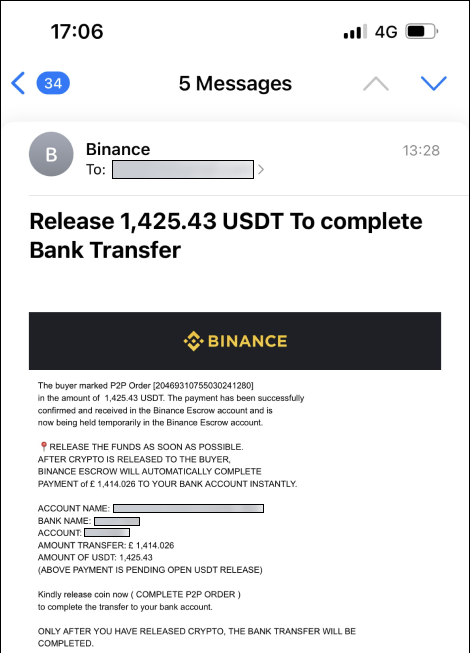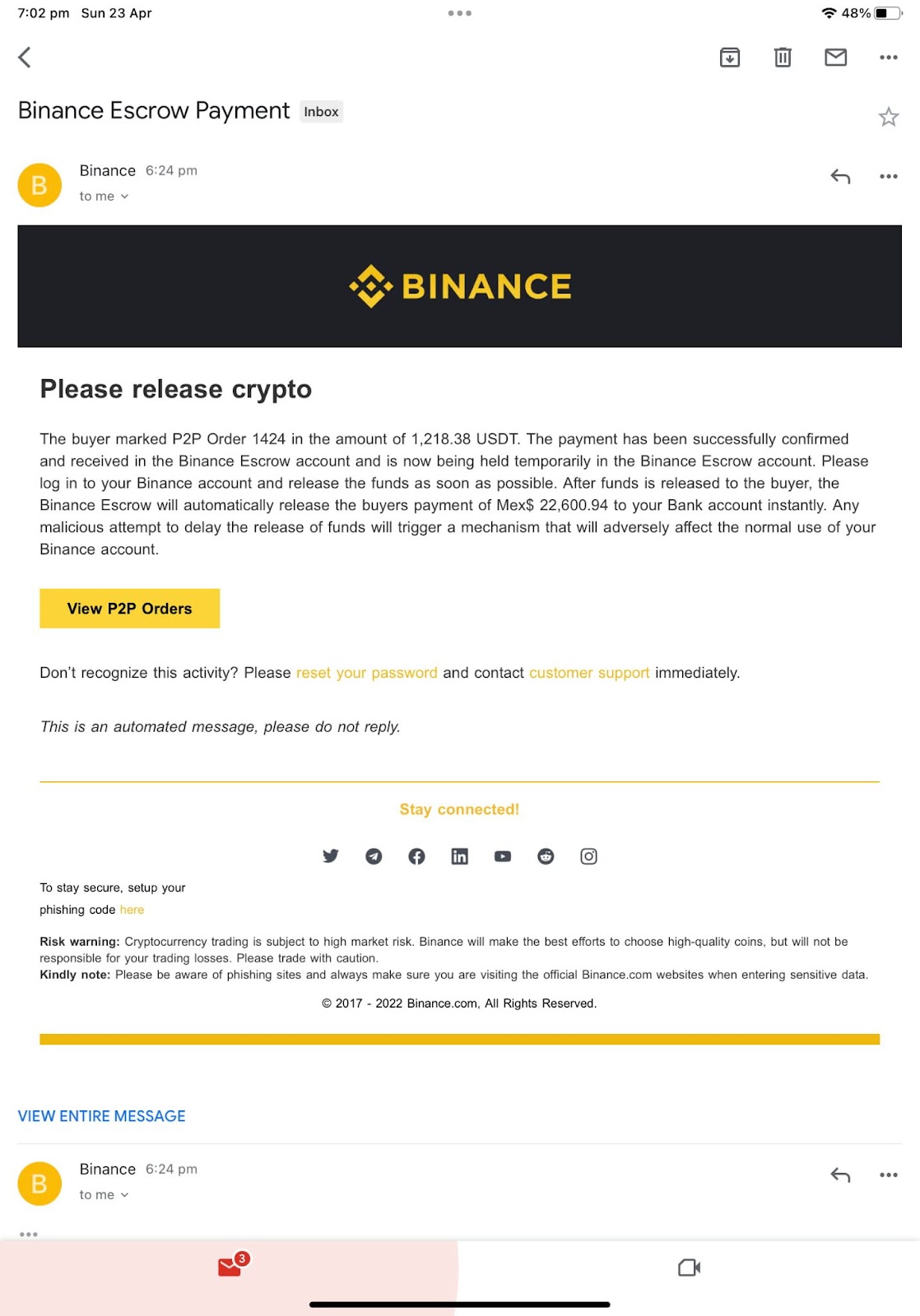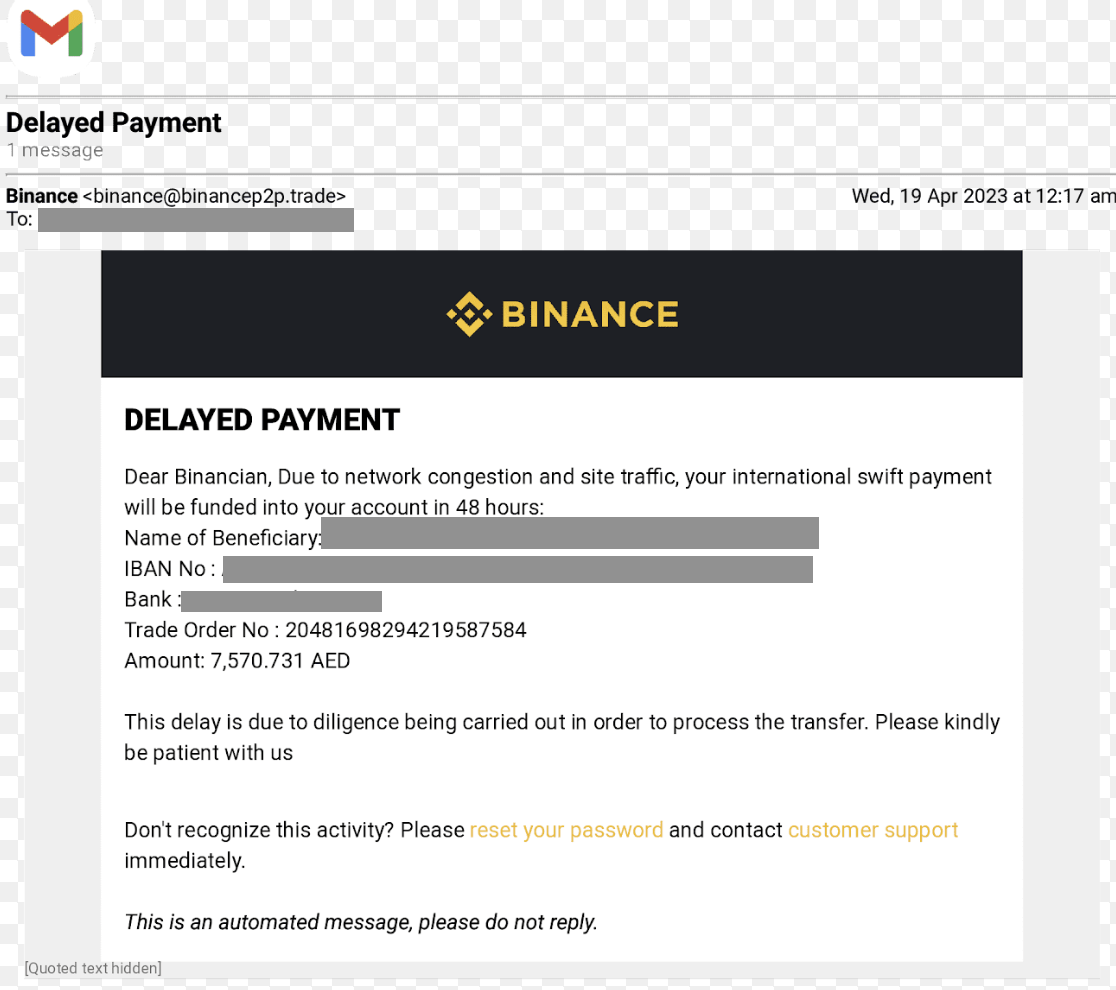Recognizing and Preventing Fake Email Scams: Stay Secure Online
Main Takeaways
Learn how to identify and avoid fake email scams by protecting your sensitive information and staying secure online.
Always make sure to check the authenticity of an email’s sender, stay up to date with security measures, and never release any cryptocurrency without confirming fiat payments.
Learn about the most common type of email scams sellers encounter while using Binance P2P.
Without a doubt, we live in a digital age. We’re all embracing technology in its new and exciting forms, but so too, unfortunately, are bad actors and scammers. Among the most common scams you’ll encounter is the fake email scam, a type of phishing attempt.
These emails are designed to trick users into releasing crypto before having received any payment in their bank accounts.
Fraudsters have become more sophisticated in their methods, making it harder for people to identify and avoid such scams. However, with this article, you’ll learn exactly how to spot and avoid fake email scams and keep your personal information safe online.
How Fake P2P Email Scams Work
Fake P2P email scams work by tricking users into believing they can release their assets to the P2P counterparty. The buyer could claim that their fiat payment is held in escrow by Binance, for example. The scammer would then ask the seller to check their email for a message that supposedly supports their claim. However, this email is actually fraudulent.
Once the seller releases the cryptocurrency, the scammer takes both the crypto and keeps their funds (as they never actually made the payment). When the seller releases the cryptocurrency, it becomes difficult to recover because they've already confirmed receiving the fiat money.
Our example above is just one of the common methods used for P2P email scams. Being aware of the different types of scam emails out there will ultimately help improve your security.
Four Common Fake Email Scams and How to Identify Them
Release crypto
The scammer will claim that your fiat funds are safely held in escrow by Binance and insist you release your coins. They could even go as far as sending a fraudulent email, falsely confirming the presence of your fiat money in a Binance escrow service, along with a threat to block your account if you fail to release the cryptocurrencies.
You can spot this attack by looking out for:
Grammar and spelling errors in the messages/emails you receive.
Suspicious sender addresses (eg, @binancep2p.trade.com).
Requests to release crypto in a hurry.
Emails or messages saying that the funds are in escrow, and you will receive the money after you release the cryptocurrency.
Phishing emails
These emails often include a call-to-action, enticing users to click a link. The link, however, will direct them to a counterfeit website designed to closely mimic a legitimate one. Subsequently, users are pressured to input their login credentials, which are then seized by the scammer.
You can spot this attack by looking out for:
Grammar and spelling errors in the messages/emails you receive.
Suspicious sender addresses (e.g., @gmail.com instead of the official domain @binance.com).
Links that appear harmless but direct to unexpected or fake websites.
Emails that do not include your anti-phishing code.
Delayed payment
You receive an email stating that, due to a network issue, the transfer will be delayed. Nevertheless, you're assured of receiving the payment within 48 hours. Simultaneously, the buyer pressures you to release the cryptocurrency. In fact, the payment isn’t delayed and simply hasn’t been sent.
You can spot this attack by looking out for:
Grammar and spelling errors in the messages/emails you receive.
Suspicious sender addresses (eg, @binancep2p.trade.com).
Requests to release crypto in a hurry.
Warnings from the buyer of network congestion or other potential delays.
Tech or CS support scams
Scammers claim to be tech support agents from Binance, informing users of issues with their devices and offering assistance. However, the process often involves granting the scammer remote access or providing sensitive information that can be misused.
You can spot this attack by looking out for:
Unsolicited tech support offers.
Requests for remote access to your device.
Requests to pay for support with unusual payment methods.
Attachment scams
Fake emails can often contain malicious attachments, such as PDFs or word processing files, which can infect your device with malware or viruses when opened.
You can spot this attack by looking out for:
Unexpected or unsolicited attachments.
File names that are inconsistent or unrelated to the email’s content.
Suspicious or harmful file extensions (e.g., .exe, .js, .vbs).
Tips for Protecting Yourself From Fake Email Scams
Look for the red flags mentioned above and trust your instincts!
Always double-check the email sender’s address and the authenticity of any websites you visit.
If you’re unsure about an email, contact Binance customer support or check our guide on how to identify phishing emails.
Don’t provide sensitive information via email or input it into unfamiliar websites.
Keep your devices and security software updated to protect against the latest scams and malware.
Don’t release any cryptocurrency as a P2P seller if you didn’t verify you already received the fiat money. You can open an appeal if you have any issue with the payment
Remember that Binance P2P doesn’t process fiat payments nor escrow fiat currencies.
Activate the anti-phishing code feature on your Binance account.
Stay Safe By Educating Yourself on Scams
Fake email scams can be quite convincing, but by educating yourself on their tactics, you can better guard yourself and your assets. Remember to stay vigilant and always think twice before taking any action prompted by a suspicious email or person! And, as always, don’t hesitate to reach out to Binance if you have any doubts at all.
Remember: it’s better to be safe than sorry!
Get Started With Binance P2P
Ready to start trading on Binance P2P? Register a new Binance account or download the Binance app. Once you've completed your identity verification, you can start buying and selling crypto on the Binance P2P marketplace.
Further Reading
Disclaimer: Your use of Binance P2P services and all information and other content (including that of third parties) included in or accessible from Binance P2P services is at your sole risk. Our only responsibility is to handle crypto transactions. All payments are final upon completion unless otherwise required by law. The Binance P2P platform has neither the right nor obligation to resolve any disputes arising from a completed payment. Neither the Binance P2P platform nor its merchants shall be responsible for any loss after a completed payment.




